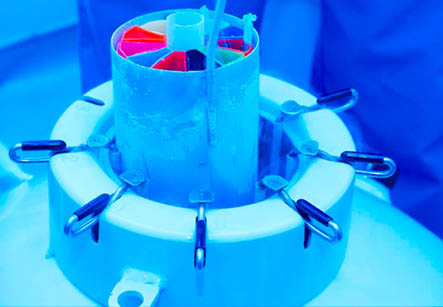Sperm Freezing
Introduction
• Sperm freezing is a technique in which male spermatozoa are frozen for future use in artificial insemination or other fertility treatments like IVF, or be donated.
• These donated sperms are first stored for a period of six months before it can be used in treatment for the purpose screen the donor for infections.
• By this procedure, the sperms can be frozen and thawed for more than 40 years without any risk.
Indications:
The procedure of cryopreservation of sperms is indicated in many situations:
• Men having cancer before starting chemotherapy or radiotherapy because these modalities of treatment are toxic for sperms and also can abolish the person’s ability to produce sperms.
• Before undergoing vasectomy. Sperms can be used at a later time if required.
Iran ranks first in the region in terms of infertility treatment studies

• Men having progressively low sperm count and producing sperms of diminishing quality over time
• Men having difficulty in producing a sample on the very day of fertility treatment.
• For the use of sperm donation in which freezing is required for further testing.
Steps before sperm freezing:
• The process of freezing and storage of sperms is explained by the doctor to the patient or donor thoroughly.
• Patient is screened for infectious diseases, like HIV and Hepatitis B and C.
• Written, informed and valid consent is taken before storing of sperms.
• A fresh sample of semen is produced in the clinic or hospital.
Procedure of storage:
• A detailed seen analysis is performed on the first sample for quality and quantity of sperms.
• Immediately after the analysis, the specimen is divided in small batches and shifted into vials for freezing. A special compound i.e. cryoprotectant is added to the vials to prevent formation of ice crystals in the sperm cells.
• These containers are slowly frozen in vapors of liquid nitrogen. After a holding period of thirty to sixty minutes they are transferred into liquid nitrogen tanks for permanent freezing at -196 degree Celsius.
• After a period of 48 hours of initial freezing, a test sample is thawed and undergoes repeat testing to make sure whether the sperm sample survived the freezing procedure well or not.
• These results are sent to the patient and also to the fertility specialist. From this information, which samples should be used for insemination can be decided.
The consent form also addresses other situations like:
• Fate of the sperms if the patient dies or becomes unable to make decisions for himself.
• The length of time for sperm storage
• Whether the spouse of the patient can use the sperm later to create a family.
• Whether to accept the parenthood of any child born as a result of fertility treatment with these sperms after the death.
• Any other conditions
Patient can cancel the consent at any time before the treatment or before the sperm are used for research.
Storage time:
Patient can store the sperms for a period of 10 years normally.
Patient can store the sperms for a period of 10 years normally. The period can be extended up to 55 years only under special circumstances depending on the clinician. If the address of the patient changes in this tenure, patient should inform the doctor. Otherwise it is considered as end of the storage period.
Conception chances with stored sperms:
Sometimes, sperms do not survive or are damaged during freezing. Some frozen sperm samples of poor quality are not capable of fertilizing the ovum on their own. They can only be used for Intra-cytoplasmic sperm injection (ICSI) i.e. injection of sperm directly in the ovum by a needle.
Success rates:
For each treatment cycle of IVF, the success rate varies depending on the age of the woman. The reason behind this is that the fertility diminishes with increasing female age.
Depending on the age:
• 35years and below, the success rate is around 19%
• 35–39, the success rate is around 15%
• 40–42, the success rate is around 7%.
Thus, sperm freezing is a versatile technique for augmentation of human fertility.